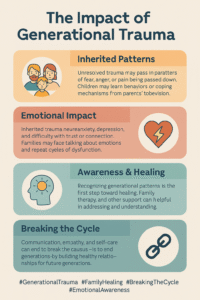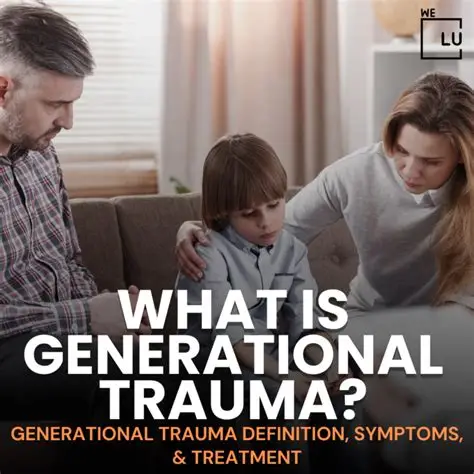Generational trauma—also called intergenerational or ancestral trauma—refers to emotional pain and coping patterns passed down through families, often without anyone realizing it. It can shape how people communicate, handle conflict, express love, and manage stress. You might see it in recurring family patterns like emotional distance, fear of vulnerability, or cycles of addiction and abuse. These aren’t coincidences—they’re learned responses to unhealed pain. Even if you haven’t faced trauma directly, its effects can still influence your beliefs and mental health. In this discussion, I’ll explain how generational trauma develops, how it’s passed down, and what steps can help you break the cycle and begin healing for yourself and future generations.
Understanding Generational Trauma
Generational trauma is what happens when big emotional wounds, such as war, systemic discrimination, forced migration, or family abuse, don’t just stop with the people who went through them firsthand. Instead, the pain lingers and can be passed down to kids, grandkids, and even further. It’s not just about family stories or old hurts being shared. It’s about the stress and coping patterns getting wired into how families act, feel, and connect with the world.
The tricky part is that you might not always know the source. Sometimes, people notice it when patterns repeat, like feeling anxious when someone raises their voice, or being cautious without knowing why. Researchers have found that trauma can switch up family communication, core beliefs, and even how people process stress. These habits get passed along through family life, and even, according to some research, through epigenetic changes that make specific stress responses more likely to show up in future generations (NCBI resource).
For example, families who have experienced poverty or persecution may find themselves constantly on edge about safety or resources, even generations later. Some children grow up feeling an unspoken sense of fear or urgency that seems woven into daily life. This is a signal that something bigger might be at play—generational trauma subtly steering family emotions and reactions over time.
How Generational Trauma Gets Passed Down
The handoff of generational trauma isn’t always obvious; it slips through in small ways and bigger family rules. Here are some common ways it happens:
- Parenting styles: A parent who grew up in survival mode, perhaps in a war zone or an abusive home, might have really strict or protective ways of raising kids. Even if there’s physical safety now, old worries might still appear in how they interact.
- Family silence: Sometimes, past trauma is just never talked about; this leaves gaps in the family story or creates an air of anxiety, making kids feel like there’s something to tiptoe around without knowing what it is.
- Overcompensation: Some families swing the other way, and parents might push for high achievement or pressure kids to be “perfect” to make up for old family hardships.
- Modeling stress: If people in your family always expect the worst or go straight into a fight-or-flight mode over small things, that can set the tone for how you handle stress yourself.
There’s also a biological side to this. Recent studies suggest that severe traumatic stress can change gene expression, not by changing DNA itself, but by flipping “switches” that influence how the body reacts to stress. These changes can travel across a generation or more (Psychology Today).
Effects of Generational Trauma on Mental Health
You don’t need to have lived through the original traumatic event to feel the impact. Growing up with generational trauma shapes the way people see themselves, others, and how safe (or unsafe) the world feels. Some widespread effects include:
- Anxiety and hypervigilance: Always scanning for danger even when things are relatively calm, often without understanding the root source.
- Depression or hopelessness: A sense that things won’t ever get better, which can sometimes trace back to old family losses or patterns.
- Difficulty with trust: Finding it tough to open up, worrying that the rug will be pulled out, or expecting betrayal.
- Relationship struggles: Communication breakdowns, trouble setting boundaries, or swings between being too distant and attached.
- Identity confusion: Feeling of not knowing where you fit, sometimes caused by being caught between old and new cultural expectations or values passed down in the family.
Other people might notice chronic health issues, recurring nightmares, or struggles with addiction patterns that seem to have no direct cause in their own lives. People might not link these feelings or life challenges to anything in the family’s past. However, when patterns run through generations, it can help to check out how family history may be involved.
Recognizing Generational Trauma in Your Own Life
Figuring out whether generational trauma is playing a role in your life doesn’t mean playing detective or blaming past generations. Sometimes, it’s just about mapping patterns and asking honest questions. Here are some things I usually look for:
- Repeated family patterns, like the same types of arguments, breakups, or secrets showing up over decades.
- Family stories about significant losses, fleeing danger, surviving discrimination, or messy relationship histories.
- Strong emotional reactions that seem “bigger than the situation” or don’t always make sense for your personal experience.
- Talking to family about specific topics or sensing lots of “unsaid” history at family gatherings is difficult.
It’s ok if you can’t immediately piece together the whole story. Even small steps to spot the patterns can help you make choices about your own healing and mental health. In some communities, connecting with elders or relatives who hold oral traditions can fill in the missing pieces, while in others, creative outlets like art or music can help process that underlying family story.
Addressing and Healing Generational Trauma
Healing generational trauma is possible, though it can sometimes feel daunting. It often involves a mix of personal reflection, professional help, and sometimes extended family or community support. Here’s what usually helps:
- Therapy and counseling: Working with therapists who understand trauma and family systems can be helpful. Modalities like EMDR or somatic experiencing are worth checking out, since they go deeper than just talking and work on patterns stored in the body.
- Family conversations: If it’s safe, asking gentle questions or discussing family history can help. Sometimes, all it takes is for a relative to share their story so that hidden worries start making sense.
- Creating new rituals: Starting healing traditions (like a family dinner, lighting a candle, or volunteering together) helps build new meaning and connection.
- Individual coping skills: Grounding techniques, mindfulness, journaling, and moving your body (like walking or dancing) help manage stress when old patterns get triggered.
- Learning more: Books and podcasts on family trauma, like Mark Wolynn’s “It Didn’t Start with You,” can help you see you’re not alone and bring more clarity to your experience.
The point isn’t about fixing the past but finding healthier ways to respond, creating boundaries, and building peace for yourself or your family moving forward. Many people find that connecting with communities that share similar histories or seeking guidance from support groups, either online or in-person, helps provide validation and resilience along the way.
Common Challenges and How to Work Through Them
- Feeling guilty or responsible: Sometimes learning about generational trauma stirs up guilt or blame, like “why didn’t someone fix this?” or “am I the only one noticing?” It helps to remember trauma isn’t anyone’s fault. Healing is possible even if you’re the first person in your family to discuss these things.
- Resistance or denial from family: Not everyone will be ready to discuss trauma, especially if the wounds are deep or come from cultural taboos. Being patient, setting boundaries, or seeking support outside the family makes a big difference.
- Worry about ‘reopening old wounds’: Sometimes, revisiting family history brings up pain. If things get heavy, it’s essential to go at your own pace, take breaks, and have support, like trusted friends or professionals.
It’s also worth noting that healing can be slow, and setbacks are normal. Remind yourself that every step forward—no matter how small—contributes to a healthier future for you and potentially those who come after you.
Frequently Asked Questions
Here are some questions that come up a lot when people begin learning about generational trauma:
Question: Can trauma actually be passed down biologically?
Answer: There’s solid evidence that traumatic stress can influence gene expression through epigenetics. While it doesn’t change your DNA, it can affect how your body responds to stress, and those changes might be seen in future generations.
Question: How can I break the cycle of trauma in my family?
Answer: Small changes add up. Seeking therapy, open communication about family experiences, building coping strategies, and creating new healthy rituals can all help change patterns—even just for yourself or your kids.
Question: What if I don’t know much about my family history?
Answer: You don’t need all the details to notice patterns or start working on healing. Focus on how family stress or emotions appear first, and work with what you know. Support from a counselor or community can also fill in those blanks.
Finding Your Path Forward
Dealing with generational trauma isn’t about blaming anyone or erasing the past. It’s about understanding why specific patterns appear and making choices that promote better mental health, wellbeing, and connection for yourself and those who come after you. Awareness is a decisive first step, and plenty of resources are ready to help anyone starting this process. If you recognize these patterns in your life, you’re not alone; your story absolutely matters.
Video:

